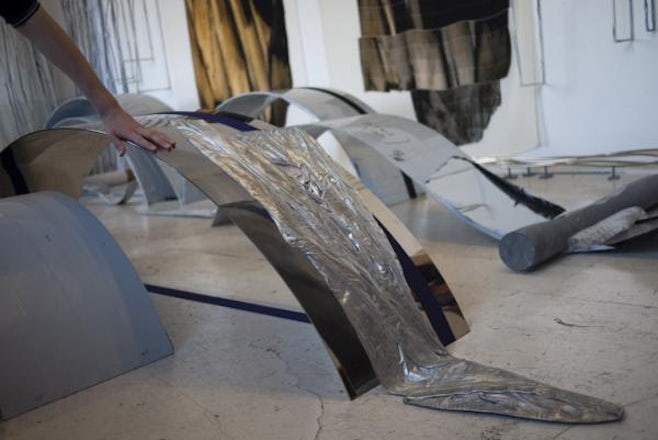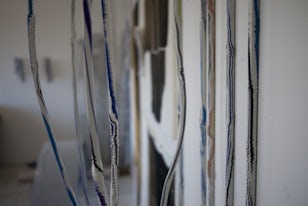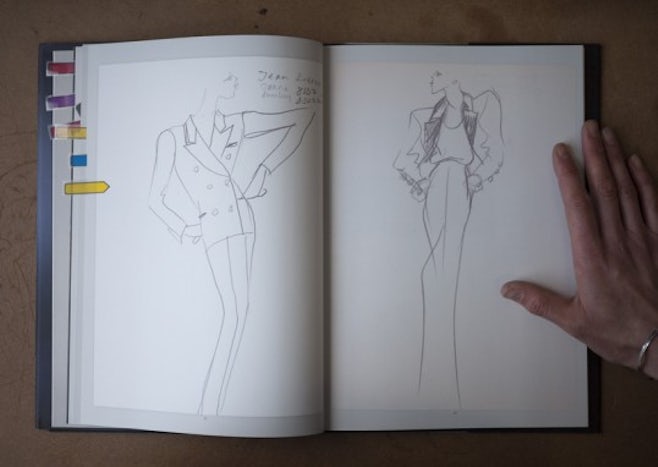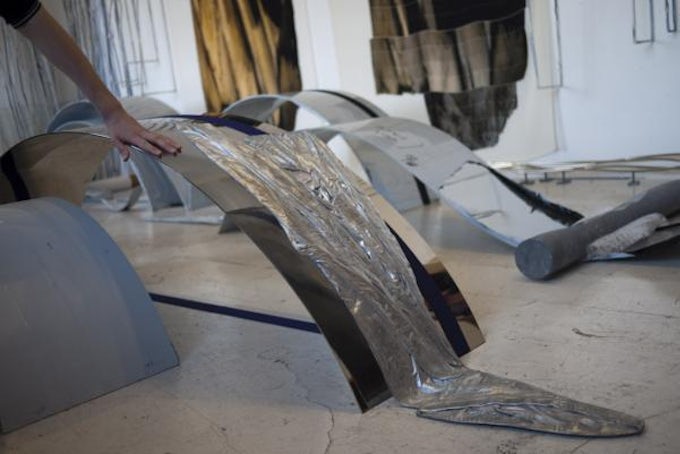
British artist Alice Channer’s sculptural practice is deeply concerned with the way things are made, and draws on a wide range of references, materials and processes. She uses both industrial and what she calls ‘post-industrial’ processes, such as digital printing and retouching, and by doing so questions hierarchies and values in relation to hand-made and manufactured products and to consumer culture overall.
For her exhibition at South London Gallery (SLG), her first solo show at a public art institution in the UK, Channer has made a new installation of works, all made in 2012, that stretches across the impressive height of the gallery, as well as the full length of the space, negotiating different senses of scale in relation to the human body. The works Cold Metal Body, Large Metal Body andWarm Metal Body each contain an image used on a human scale and another that has been stretched to a non-human scale. The digitally printed fabrics of these three works hang suspended from the ceiling, while other pieces span the space horizontally. This is the case with the low freestanding sculptures Amphibians and Reptiles and the sequences of aluminium frames hung perpendicular to the walls, titled Lungs and Eyes.
In this interview, which took place at the artist’s studio two weeks before the show’s opening, Afterall’s Line Ellegaard discusses with Channer the making of these works and the elements of craft versus industrial processes pertaining to her practice, as well as notions of embodiment in relation to clothing and the world around us.
LINE ELLEGAARD: I’m interested in the relationship of site-specificity to your work. Even though your works can be placed in different spaces, and are not site-specific as such, they seem to have close relationship to the space in which they are installed. How have you approached making work for the galleries at the South London Gallery? And how has it been to conceive of work for such a large space?
ALICE CHANNER: A lot of artists have made changes to the architecture at the SLG, and the first thing I knew was that I would take the gallery as it is. It would be me versus the room. I am imagining a very linear arrangement of works in the space, yet the exhibition is without a centre and the works are not linear. Everything moves up and down and also along.
I have never made horizontal freestanding floor-based sculpture before, and it might seem quite odd to approach a room that is ten metres high with these very low sculptures. But I hope that as I look down into their shiny surfaces (they are made of mirror-polished stainless steel) they will acknowledge what is above me, so in their horizontality they acknowledge the verticality.
The other challenge with the room at the SLG was how to include the two twenty-metre-long walls in the exhibition. To try and bring them into the work I have made Eyes and Lungs, two groups of aluminium frames covered in spandex that has been digitally printed with a massively stretched and distorted print of my arm. I rolled ink over my arm and made prints with it, these were then scanned and made into a fabric design. Each one of these lines on the print is my arm stretched two metres long and hugely contracted – often in the work there is an expansion and contraction. In a really simple way all the works in the show are to do with breathing, and I imagine these groups of frames will expand and contract as I walk around the room. They are an attempt to animate inanimate matter. The curves on the side of each frame are taken from Yves Saint Laurent’s drawings of his ‘le smoking’ suit, and again they are stretched. For every seasonal collection he made a suit for women instead of a wedding dress. I like his expressive lines – it is a body flattened into a pose and an attitude.

LE: The relationship to clothing or to wearing something seems very important in your work. You include references to high-street consumer products, for example, by making casts of a pair of leggings from Topshop (in the work Reptiles, 2012) and you also have references that are very specific to the history of fashion, like YSL’s ‘le smoking’. How do you see the relationship between these two?
AC: I suppose I want both. My work will often start with a detail or something really small scale, which is then expanded massively. I want there to be this awkward intimacy, like the experience of wearing clothes, which is so intimate and so habitual. At a completely different kind of scale there is YSL: a brand name, a person, a myth, part of capitalism and part of art. I want both of those things in the work.
LE: The drawings by YSL are icons of a certain classic style.
AC: Yes, what interests me most in Yves Saint Laurent is that he was a classicist. I am currently thinking about ‘the classical’, and especially what the idea of ‘classical time’ might be in relation to my work. By this I mean the idea that there are things that never change. To some extent I see this as the enemy, and something I am working against, but I also have a human need for things that go beyond what is immediate. I think I have found a way to approach ‘the classical’ and include it in the work through clothing, and through clothing’s mutability and ability to exist in the present. I also think of the work as a whole, and particularly a solo show, as something in which I am trying to include different kinds of time. In ‘Out of Body’, I hope, there will be human, capitalist and classical kinds of time, all existing alongside each other in the same room.
LE: What kinds of ‘time’ will the other works in the show draw on?
AC: A starting point for the works Cold Metal Body, Large Metal Body and Warm Metal Bodyare three classical stone sculptures from the British Museum made in 390 BCE titled Three Nereids. The statuaries’ heads and limbs are all broken off, and pretty much all that is left is the drapery – and yet there is an incredible vitality in them. I am fascinated by these sculptures, and particularly their garments, because it seems to be the drapery that guarantees them their life, their immediacy and connection to the present.
A lot of the work in the SLG show has to do with scale, and trying to negotiate between human and non-human scale, and human and non-human materials and production processes. But the human and non-human scale is most literally taken on in the Body works: I have taken the drapery from these human-scale stone objects and made it into a digital file, and then stretched it to a non-human scale of ten metres.
LE: What interests you in the relationship between clothing and sculpture?
AC: All of my work over the last couple of years has had to do with making curves. And all of the curves are in relation to a human body. Clothes are objects that I am inside of, that I am most intimate with. They exist between the subjective and the objective, and I am always trying to cross the bridge between the two in my work. What fascinates me about them as objects is that they are in between the two-dimensional and the three-dimensional, and need to be embodied in order to be given shape and context. I mean – are clothes really even objects?
LE: It feels like a great tension in your work, as well, that you make sculpture out of in-between objects… Is this something that relates to your experience at art college?
AC: The two art colleges I went to, and what they each represented, are very important for me. I did my BA at Goldsmiths in London, which was a very conceptual college but one that also simply replicated the condition of being an artist now – anything was possible. It can be liberating but it can also be inhibiting, as it presents you with the biggest questions to begin with. After Goldsmiths I wanted to go to a conservative sculpture school and I went to the Royal College of Art, also in London. There they had the idea that sculpture would be a big heavy object in the middle of the room. I went with a real desire to make a sculpture and a real fascination for what sculpture was.
I always try to make something three-dimensional and yet all of the objects that I make are made from flat surfaces. I quite literally have to pleat, fold, stretch, curve, expand and contract in order to give them volume and to make them stand. I guess that relates back to clothing, to trying to give these materials bodies so they can exist independently of me as sculptures.
LE: I was wondering about the way that you combine materials and processes – like marble, digitally printed fabrics, aluminium and elastic. It seems as if you use the materials that surround us in our post-industrial world and take them through a process of craft, by casting them in aluminium or bronze: do you agree with this description?
AC: It does not feel like I am trying to do that. At the Royal College I was definitely not someone who was a craftsperson or someone who was technically able. The technicians laughed at the way I made moulds. The foundry that makes casts for me now mainly casts figurative sculptures of world leaders to an incredible degree of accuracy. When I first brought them a wax cast of a waistband with an air bubble left in the top they were surprised that I saw enough value in it to want to cast it in metal. But I wanted to keep the bubble as a memory of that part of the process when it was liquid. In this way there is an element of disrespect for what they see as craft, and what they would value. I can use those processes, but I bring something else to it.
Everything in the world can easily look very opaque, and what is therapeutic about making art, for me, and what I enjoy the most, is finding out how things are made. Therefore I try to enter into industrial and post-industrial production processes, but not necessarily because I see them as anonymous. In my experience of making art I have found that there is no such thing as anonymous ‘mass production’ – everything is made by someone, and that is such a relief to know. For example, an iPhone is put together by people, and in a similar way so is my work, and that has direct political and social implications that are not necessarily apparent on its surface.
LE: You have described installing your work at Tate Britain for the Art Now programme in 2008 like dressing the body of the museum. Do you see the space at the SLG as a body that needs dressing as well?
AC: The room in itself has a materiality, and that is why I want to include the walls, the floor, the ceiling. I suppose I do treat it as a body, not something neutral or empty. I also treat it as an author. I wrote a brief text about the exhibition to help write the press release, where I said that ‘‘‘Out of Body’ is a show with many different authors and only one of them is me’. Often, when I use these industrial processes and post-industrial processes, a sort of shared authorship of the work emerges. For example, at the bottom of the digital fabric prints the manufacturers write my name, and then some notes about the production. I see that very much as the signature of the process, because this was written in the place where it was made. But it is also my signature, because it has my name in it.
LE: And how does this notion of embodied space relate to title of the exhibition, ‘Out of Body’?
AC: It feels like a provocative title, because I am not asking for a disembodied experience. ‘Out of Body’ is about what it means to be embodied today. Where is my human body in relation to all the flat surfaces that make up the world I live in – the clothes that I wear, computer screens, cash points, architecture and industrial surfaces? That is the question I ask again and again. Similarly, for the surfaces of the SLG – where is the human body in relation to those?
Alice Channer, ‘Out of Body’ is showing at the South London Gallery from 2 March – 15 May 2012. www.southlondongallery.org/alicechanner

